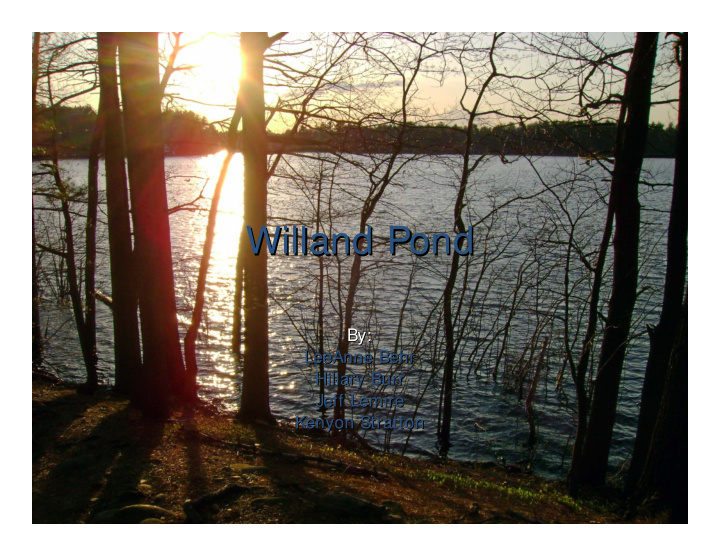



Willand Pond Willand Pond By: By: LeeAnne Behr LeeAnne Behr Hillary Burr Hillary Burr Jeff Lemire Jeff Lemire Kenyon Stratton Kenyon Stratton
Special Thanks To: Special Thanks To: � Dover Town Planner, Chris Parker Dover Town Planner, Chris Parker � � Somersworth Director of Development Services, Somersworth Director of Development Services, � Craig Wheeler Craig Wheeler � Somersworth Town Planner, Dave Somersworth Town Planner, Dave Sharples Sharples � � Dover residents who took part in our surveys Dover residents who took part in our surveys � � Dr. James Haney and Dr. Alan Baker Dr. James Haney and Dr. Alan Baker � � Shane Shane Bradt Bradt, Amanda , Amanda Murby Murby, Paul Currier, , Paul Currier, � Jacquie Colburn, Darlene Forst Forst, Rob , Rob Roberston Roberston, , Jacquie Colburn, Darlene and Mark Gallagher. and Mark Gallagher.
Advisory Advisory We are finishing a class project on the We are finishing a class project on the projection of Willand Pond. We are providing projection of Willand Pond. We are providing the towns of Dover and Somersworth with a the towns of Dover and Somersworth with a preliminary management direction. This talk preliminary management direction. This talk will state areas that need to be further will state areas that need to be further explored and possible actions that may need explored and possible actions that may need to be taken. to be taken. Thank you. Thank you.
Willand Pond Willand Pond Towns of Somersworth and Towns of Somersworth and � � Dover, NH Dover, NH Strafford Country Strafford Country � � Surrounded by commercial Surrounded by commercial � � development, residential development, residential homes, forest, and wetlands homes, forest, and wetlands Fishing, boating, walking, Fishing, boating, walking, � � skating, swimming, skating, swimming, canoeing/kayaking, birding canoeing/kayaking, birding & wildlife watching & wildlife watching Kettle Lake Kettle Lake � � Recent concerns about algal Recent concerns about algal � � blooms and the cause blooms and the cause
What is a Kettle Lake? What is a Kettle Lake? A lake is not an isolate body of A lake is not an isolate body of � � water, it is part of a larger water, it is part of a larger ecosystem. ecosystem. Found in glaciated regions Found in glaciated regions � � Deposits of meltwater meltwater and ice and ice Deposits of � � within debris from retreating within debris from retreating glacier glacier Hundreds of years for ice to Hundreds of years for ice to � � melt melt Morphometry determined by determined by Morphometry � � ice and the overburden of ice and the overburden of debris debris Irregular in shape, size, slope Irregular in shape, size, slope � � and flushing and flushing Generally shallow depth Generally shallow depth � �
What does this mean for Willand? What does this mean for Willand? � Little drainage Little drainage � � Inflow from precipitation, runoff, and Inflow from precipitation, runoff, and � ground water ground water � Water was previously removed from the Water was previously removed from the � lake as a drinking source lake as a drinking source � More liable to flood More liable to flood �
More Incoming Water May Mean More Incoming Water May Mean More Phosphorous More Phosphorous � Elemental components of a lake include carbon, Elemental components of a lake include carbon, � nitrogen, hydrogen, oxygen, sulfur, and nitrogen, hydrogen, oxygen, sulfur, and phosphorus (P) phosphorus (P) � Phosphorus is a basic element. Phosphorus is a basic element. � � P is a key element in all known forms of life with P is a key element in all known forms of life with � a primary role in biological metabolism. a primary role in biological metabolism. � Total P can be from less than 1 microgram/L to Total P can be from less than 1 microgram/L to � 200 mg/L – – average levels for fresh water are average levels for fresh water are 200 mg/L less than 10 micrograms/L less than 10 micrograms/L
Where Is Phosphorus From? Where Is Phosphorus From? � Internal loading Internal loading – – � exchange between exchange between sediments and the sediments and the overlying water overlying water � External loading External loading – – added added � in from external sources in from external sources (such as human sources) (such as human sources) � Atmospheric precipitation Atmospheric precipitation � � Ground water Ground water � � Land Runoff Land Runoff � � Increases productivity of Increases productivity of � the lake the lake
Eutrophication by Phosphorus by Phosphorus Eutrophication � Lakes are often limited by P and can have C and N in Lakes are often limited by P and can have C and N in � excess amounts excess amounts � 1P : 7N : 40C 1P : 7N : 40C � � Eutrophy Eutrophy – – signifies nutrient rich waters and increase signifies nutrient rich waters and increase � biotas biotas � More phytoplankton and is common in areas with an More phytoplankton and is common in areas with an � increase in the supply of nutrients due to humans. increase in the supply of nutrients due to humans. � P becomes recycled and is taken up by algae, P becomes recycled and is taken up by algae, � cyanobacteria, bacteria, and larger aquatic plants. cyanobacteria, bacteria, and larger aquatic plants. � Average cyanobacteria and algae abundance has been Average cyanobacteria and algae abundance has been � positively associated with total and average P positively associated with total and average P concentrations. concentrations. � Algae thrive in water that is over 20 Algae thrive in water that is over 20 microgramsP microgramsP/L /L �
Recommend
More recommend